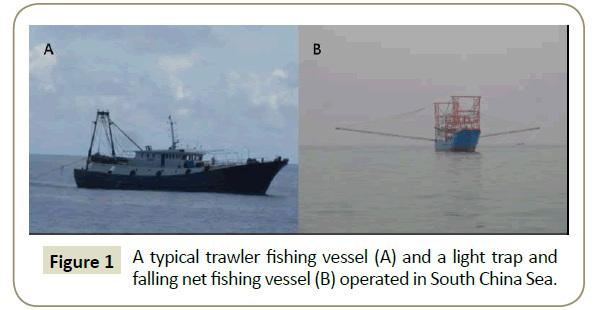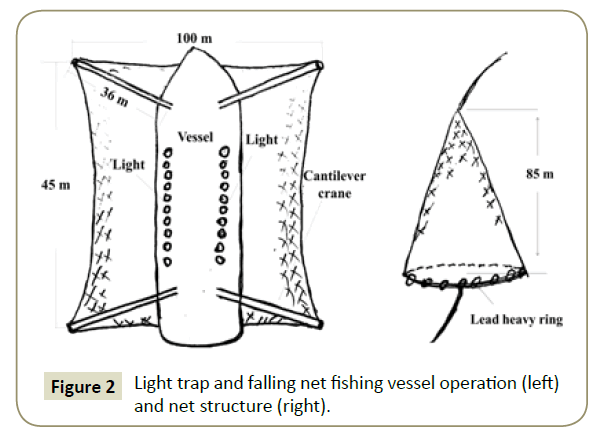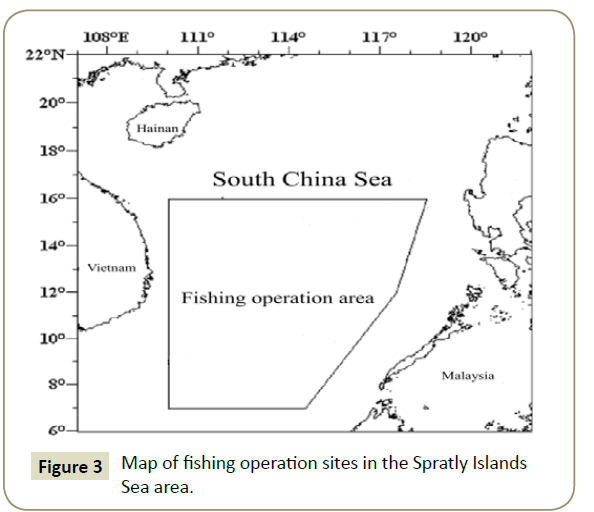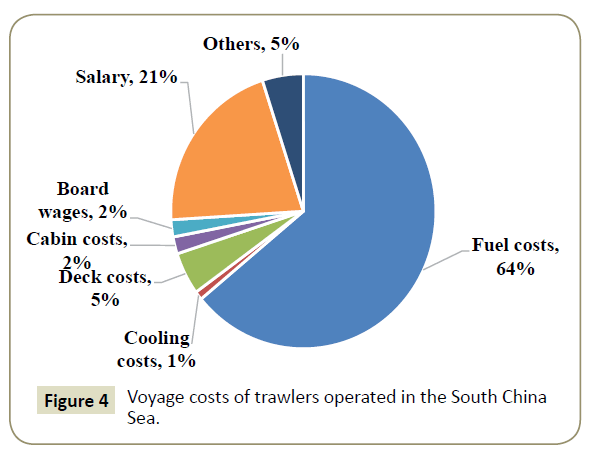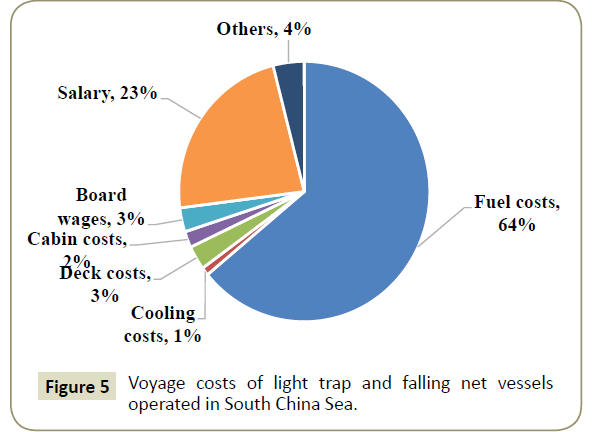Economic Benefit Analysis of Trawlers and light trap and falling net fishing vessels in South China Sea
Miao Jiang1, Shengwei Ma1, Zhenhua Ma1,2, Jianwei Zou1, Shaosen Wu1, Fenghao Lin1, Jian G. Qin2and Qia’er Wu1*
1Key Laboratory of Open-Sea Fishery Development, Ministry of Agriculture, South China Sea Fisheries Research Institute, Chinese Academy of Fishery Sciences, Guangzhou 510300, China
2College of Science and Engineering, Flinders University, GPO Box 2100, Adelaide, SA 5001, Australia
- *Corresponding Author:
- Qia’er Wu
Key Laboratory of Open-Sea Fishery Development
Ministry of Agriculture, South China Sea Fisheries Research Institute
Chinese Academy of Fishery Sciences
Guangzhou 510300, China
Tel: +86 0898-83361232
E-mail: wqe66@163.com
Received date: June 09, 2018; Accepted date: July 02, 2018; Published date: July 09, 2018
Citation: Jiang M, Ma S, Ma Z, Zou J, Wu S, et al. (2018) Economic Benefit Analysis of Trawlers and light trap and falling net fishing vessels in South China Sea. Insights Aquac Cult Biotechnol Vol.2 No.1:5
Abstract
This study analyzed the production records of fishing vessels equipped with either a trawl net or a light trap and falling nets to catch fish at the Spratly Islands Sea in the South China Sea for five years. In the trawling vessels, the annual production output was ¥632,400 (Chinese renminbi yuan, 1¥  0.15USD) and the annual voyage operation cost was ¥685,000. In the light trap and falling net vessels (lighting vessels), the annual production output was ¥602,300, and the voyage operation cost was ¥509,500. During 2011, 2012 and 2016, the economic benefits in the trawlers were significantly lower than those in the lighting vessels operated at the Spratly Islands Sea in the South China Sea. Based on the data analysis of production efficiency between these two types of fishing methods, we conclude that the fishing vessels equipped with the light trap and falling net can provide higher economic benefit than the fish vessels equipped with traditional trawling nets at the Spratly Islands area in the South China Sea.
Keywords
South China Sea; trawlers fishing vessels; light-falling net fishing vessels; economic benefits
Introduction
The South China Sea covers an area of over 3.5 million km2 with abundant fishery resources and has more than 100 fish species of high value. The geographical location and potential for developing offshore fisheries have attracted the interest of local governments, investors and fishermen to develop marine fisheries in this region [1,2]. Recent studies have shown that the biomass of the purpleback flying squid Symlectoteuthis ouralaniensis is about 11-150 million tons in the South China Sea [3]. According to the acquisition price of squid catch in 2016 averaged 7 Chinese renminbi yuan (¥) per kilogram with the total annual output value up to ¥100-140 billion. With rapid development of marine fishing industry in China, fishery production in the South China Sea has become an increasingly important source of revenue for local fishermen. Therefore, reasonable and effective fishing strategies for utilization and exploitation of the fishery resources in the South China Sea are urgently needed for sustainable development of the ocean economy.
A trawl net is a large tapered fishing net that is towed along the sea bottom or at a given depth below the surface on a fishing boat for catching fish, shrimps, crabs, shellfish or mollusks. The trawling operation has high flexibility, adaptability, and production efficiency, but can unselectively damage fishery resources, especially for endangered species or a spawning population [4]. The fishing vessel equipped with a light trap and a falling net (lighting vessel, hereafter) was developed in the early 1990’s as a new fishing gear mainly used for fishing cephalopods and phototaxic fish species [5,6]. The operation of lighting vessels is to use light to attract fish and then suddenly drop the net to catch the fish schools around the light, which is a simple and low labor-cost method to precisely control fishing operation on target species. It has become the most important fishing tool in the fishery industry in the South China Sea. Despite its popularity in fishery operation, the economic benefit between the lighting vessels and the traditional trawling vessels has not been compared. In order to improve fishery management and develop scientific protocols for exploitation of marine fishery resources, this study compared the operational outputs between the trawling vessels and the lighting vessels and aimed to identify an optimal and cost-effective fishing method in the South China Sea.
Materials and Methods
In this project, the data were collected from the Guangxi Beihai Fisheries Technology Promotion Station. The production information was monthly collected from Guangxi fishing vessels, a major fishery industry of the South China Sea in terms of fishing vessel type, voyage distance, production, output value, fishing area and time. After data collection, the information was analyzed at the National Marine Capture Information Dynamic Collection Network Center to develop the relationship between the production output and cost-benefit.
From January 2011 to July 2016, we randomly collected 108 fishing operations from 24 trawling vessels (Figure 1a) and 30 lighting vessels (Figure 1b, Figure 2), including 54 records from trawlers and 54 records from lighting vessels. The same fishing area was within an area of 50 km2 for both fishing operation modes according to the GPS records in the navigation system. All these fishing vessels were operated in the Spratly Islands area (Figure 3). The average length of the trawler vessels was 32.46 m, and the average power was 303.01 kilowatts (kw). The operation depth of the trawler fishing vessel was 50-120 m, and the operation time was 24 h per fishing trial. The average length of light-falling net vessels was 37.03 m, and the average power was 335.83 kw. The height of lighting vessels was 50-120 m, and fishing area of this type of vessels was 4500-5000 m2 for each operation. The operation duration was 10 h from 18:00 h to 04:00 h next day.
Figure 2:Light trap and falling net fishing vessel operation (left) and net structure (right).
Figure 3:Map of fishing operation sites in the Spratly Islands Sea area.
In this study, the economic benefits of two types of fishing methods were analyzed in terms of fishing operations, power usage, catch weight, catch value, operation cost and fishing days on the sea. The power usage referred to the horsepower of the vessel engine used for fishing operation. To remove the impact due to size variation between fishing vessels, power usage was used to standardize the costs between two fishing methods. The operation expenses included deck costs, cabin cost, board wages, salary, cooling, fuel and others (e.g., machinery maintenance, fishing gear repair). The economic benefit was measured by output efficiency per unit of power effort and fishing time, which was calculated with this formula: Economic benefit=(output - cost)/fishing days/vessel power. The data in this study were expressed as mean ± SD, and compared with independent T-test, and the significant difference level was set at P<0.05.
Results and Discussion
The average production output of trawling vessels was ¥632,400 and the average voyage cost was ¥685,000. The average fishing time was 71 days per voyage. In the lighting vessels, the average production output was ¥602,300 and the average voyage operating cost was ¥509,500. The average fishing time was 49 days per voyage. According to the average economic efficiency of fishing vessels in 2011-2016, the output efficiency was compared to analyze the economic benefits of the two types of fishing vessels and to explore the factors that affect the economic benefits of fishing methods (Table 1). From 2011 to 2016, the maximum economic benefits of the trawlers were ¥-0.4/day/kw in 2011 and ¥-4.61/day/kw in 2013, and the income for six consecutive years was negative. The maximum economic efficiency of the lighting vessels was ¥20.55/day/kw in 2011 and the minimum value was observed in 2013 at ¥-4.52 day/kw. Despite a trend of economic fluctuations, the fishermen were satisfied with the improved fishing income and economic loss was partially subsidized by the local government during the establishment period of offshore fisheries. The average annual economic benefit of the lighting net vessels was about 5 times higher than the trawlers, and the annual average unit power efficiency output value was also higher than the trawlers. The annual average costs of the trawling vessel and lighting vessel are presented in Table 2. The fuel cost was the highest among all costs in both trawling (¥277,200/vessel/ year) and lighting vessels (¥304,700/vessel/year). Salary costs accounted for the second highest cost in both trawling (¥100,200/ vessel/year) and lighting vessels (¥99,200/vessel/year).
| Economic benefit (Yuan/day/kw) | ||||||
|---|---|---|---|---|---|---|
| Fishing type | 2011 | 2012 | 2013 | 2014 | 2015 | 2016 |
| Trawler | -0.4 ± 3.16 | -4.39 ± 5.32 | -4.61 ± 6.14 | -1.85 ± 4.05 | -2.1 ± 7.79 | -3.01 ± 5.42 |
| Light-falling net | 20.55 ± 13.96** | 9.06 ± 4.95** | -4.52 ± 22.55 | 1.34 ± 9.42 | 5.35 ± 11.15 | 3.92 ± 8.03* |
*: P<0.05, **: P<0.01.
Table 1 The economic benefits (†renminbi yuan/day/kilowatts) of trawlers and light and falling net fishing vessels operated at the Spratly Islands area in the South China Sea
| Fishing boat type | Fuel costs | Cooling costs | Deck costs | Cabin costs | Board wages | Salary | 99.2±40.6 |
| Trawlers | 277.2±87.0 | 3.8±4.4 | 14.2±10.4 | 7.1±5.8 | 10.5±2.9 | 100.2±4.9 | 18.2±8.3 |
| Light trap and falling net | 304.7±90.1 | 1.3±0.9 | 21.8±14.5 | 10.8±7.0 | 11.9±2.5 | 99.2±40.6 | 29.5±17.5 |
Table 2 Costs of trawlers and light trap and falling net fishing vessels (cost unit: 103 Yuan per year)
The voyage cost ratios of the trawling vessels and lighting vessels from 2011 to 2016 are shown in Figures 4 and 5. The main expenses of the two fishing types were the fuel cost, ice and cooling costs, deck miscellanies, cabin utility, food and salary. The highest component was fuel, accounting for 64% (¥600,000) of the total cost, followed by salary costs. The average annual expenditure of salary was ¥180,000, accounting for 21% of the total cost in the trawling vessels and 23% of the total cost in the lighting vessels. Other costs accounted for less than 5% of the total annual expenditure (¥40,000). The fuel cost was nearly 1.78 times of the total of the other six remaining costs. The voyage cost survey shows that the costs for ice and cooling, cabin usage, food and others are relatively low. In contrast, the fuel cost was about two-thirds of the total costs and had a significant impact on the operation efficiency of fishing vessels [7-9].
From 2011 to 2016, the economic profit has been negative in trawler vessels, and the loss was ¥2.73/day/kw). In contrast, except the loss in 2013 due to the fluctuation of seafood market prices, the economic efficiency of the lighting vessels was acceptable by fishermen in the other five years, reaching ¥5.95/ day/kw. The fishery catch by the lighting vessels was high, and the economic benefit was also high [10].
The trawling net is not suitable for a large-scale commercial operation due to its poor selectivity on fish species, high energy consumption, damage to fishery resources, and impact on ecological diversity [1,11]. The catches of fish species from the trawling net are messy and difficult to classify. The amount of fish species with high economic value is low, and most of the catches are trash fish. Since trawlers have high demands on the topography of the fishing grounds, suitable fishing grounds in the South China Sea are rare. Furthermore, the Chinese government has established a strict no fishing zone for bottom fishing trawlers, which makes the capture volume of trawling fishery low. At present, the mouth diameter of trawl fishing gears operated in the South China Sea tends to be getting larger, and the mesh size of the net ball tends to be becoming smaller [12]. Consequently, with the expansion of fishing areas, fishery resources have been over-exploited in the South China Sea, which has adversely affected sustainable fisheries.
Recently, with the increasing interest of offshore fisheries, the lighting vessels have been more and more accepted as a method for offshore fishing [13]. This fishing method is to use light to trap the upper and middle dwelling fishes such as Sthenoteuthis oualaniensis, Thunnus albacore, Katsuwonus pelamis, and Decapterus maruadsi, and will not damage the marine life in other habitats and to selectively use marine resources [14]. Most of the catches from the lighting vessels are higher economic value fish species, and can be processed for sale in cans. The operation efficiency of the lighting vessels is high and the fishermen can choose fishing grounds and fish species according to fish distribution, habitat use and reproductive biology to reduce the chance for catching protected fish species [15]. Through the development of large-scale light-falling net fishing vessels, fishermen can reduce investment risk, improve fishing flexibility and increase economic benefits to explore offshore fishery resources in the South China Sea.
The trawling fishery has severely damaged the ecological environment of the South China Sea. As a result, the fishery ministry of the Chinese government has taken various measures to restrict the use of trawling nets by gradually reducing the number of trawlers, strictly implementing the mesh size standards of trawls, controlling the fishing time on the sea, and encouraging trawlers to upgrade or change the mode of operation to avoid over-exploitation of fishery resources. The Chinese government encourages and supports the manufacture of large lighting vessels, encourages offshore fishing, and establishes a supply base on Paracel Islands to solve the problem of logistics supply and reduce fishing costs. Meanwhile, forbidden fishing period management and greatly reduction of offshore fishing intensity have been implemented to protect the ecosystem and fishery resources of the South China Sea.
In summary, our results indicate that lighting vessels are the most efficient fishing method operated in the Spratly Islands region. T o improve fishery catch efficiency and economic benefits in the South China Sea, future fishery development should consider adopting the effective fishing method to support the use of largescale lighting vessels and focusing on the development of middle and upper layer fish and oceanic cephalopods in fishery capture.
Acknowledgement
This study was funded by China Ministry of Agriculture special financial funds (South China Sea Fishery Center, NFZX2013).
References
- Zou J (2012) Analysis on distribution and fluctuation of fishing effort of Guangxi trawling fleets. Chinese Fisheries Economics 4: 156-160.
- Ai H, Zhang L (2015) A preliminarily exploration of exploitation strategies for Nansha fishery. South China Fisheries Science 5:143-152.
- 3. Qiu Y, Zhang P (2013) Suggestions on exploitation and utilization of oceanic fishery resources in the South China Sea. Academic seminar on tropical Marine science and the 8th Guangdong Ocean Institute of Oceanography 204-208.
- Yang L (1998) Impact of fishing gear and fishing method on fisheries resources in the North of South China Sea and Marine Environment. Modern Fisheries Information 2: 5-9.
- Zhang J, Chen Z, Chen G, Zhang P, Qiu Y, et al.(2015) Hydroacoustic studies on the commercially important squid Sthenoteuthis oualaniensis in the South China Sea. Fisheries Research 169: 45-51.
- Zhang P, Zhang J (2016) An exploratory fishing survey of light falling-net fisheries in the central and Southern South China Sea in autumn. South China Fisheries Science 2: 67-74.
- Gao J, Zhang X (2001) Preliminary studies on production costs and economic efficiency of pair trawlers in Nantong region. Acta Agricultures Shanghai 4: 14-17.
- Li X, Liang H (2015).The analysis of the influences of fisheries diesel allowance policy on Guangdong Ocean fishing industry. Journal of Guangdong Ocean University, 5: 38-44.
- Le J, Liu C (2015) The economics explanation of fisheries diesel subsidies. Chinese Fisheries Economics 1: 49-53.
- Chen M (2013) Price analysis of Guangdong aquatic products in the first half of 2013 and forecast of the second half year. Market Economy and Price 8: 34-34.
- Zou J (2011) Analysis on situation of exploitation of southern trawling ground in the South China Sea. Modern Fisheries Information 12: 3-5.
- Chen W, Song L (2013) Using Light Falling-net Fisheries Development Sansha Fishery Resources. Ocean Development and Managements 1: 68-70.
- Zhang P, Yang L (2010) The present status and prospect on exploitation of tuna and squid fishery resources in South China Sea. South China Fisheries Science 1: 68-74.
- Wu Q, Yu G, Ma Z, Ma S, Wu S (2016) Preliminary study on the fisheries catches in South China Sea via light falling-net fishing method. International Journal of Innovative Studies in Aquatic Biology and Fisheries 2: 1-4.
- Sun Z, Zhou J (2011) Investigation and analysis of trawl gears in the Yellow Sea and Bohai Sea area. Progress in Fishery Sciences 32: 126-134.
Open Access Journals
- Aquaculture & Veterinary Science
- Chemistry & Chemical Sciences
- Clinical Sciences
- Engineering
- General Science
- Genetics & Molecular Biology
- Health Care & Nursing
- Immunology & Microbiology
- Materials Science
- Mathematics & Physics
- Medical Sciences
- Neurology & Psychiatry
- Oncology & Cancer Science
- Pharmaceutical Sciences
